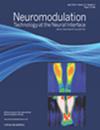Effect and Mechanism of Vagal Nerve Stimulation on Gastric Motility: A Preliminary Rodent Study
IF 3.2
3区 医学
Q2 CLINICAL NEUROLOGY
引用次数: 0
Abstract
Background
Patients with functional dyspepsia often exhibit gastrointestinal motor disorders associated with gastric myoelectrical dysrhythmia. This study investigated the effects of vagal nerve stimulation (VNS) in a rodent model of gastric slow-wave dysrhythmia induced by colorectal distention (CRD).
Materials and Methods
Male Sprague-Dawley rats were implanted with wires in the gastric body to record gastric slow waves and in the left cervical vagal nerve for stimulation. VNS was conducted over six sessions to optimize its efficacy on CRD-induced gastric dysrhythmia: control, CRD, and CRD with four different sets of parameters varying in frequency and stimulation on/off times. Both the CRD and VNS were conducted throughout the recording after the meal. Atropine was administered in two additional sessions, with or without VNS, to explore the involvement of the cholinergic pathway. The percentage of postprandial normal gastric slow waves (NSW), defined as the percentage of time during which the gastric slow wave was normal, was quantified using adaptive spectral analysis.
Results
The study findings were 1) CRD significantly reduced the percentage of NSW from 89.2% ± 1.6% to 64.3% ± 3.5% (p < 0.001), which was mitigated by VNS at 14 Hz (83.5% ± 3.0%, p < 0.001) and 25 Hz (88.4% ± 1.7%, p < 0.001); 2) atropine slightly, but not significantly, decreased the percentage of NSW to 54.1% ± 3.2% and abolished the beneficial effects of VNS at 25 Hz on gastric slow waves (60.9% ± 3.3%, p < 0.01); and 3) CRD delayed gastric emptying, which was restored by 25 Hz VNS.
Conclusion
VNS using optimal parameters effectively ameliorated CRD-induced gastric dysmotility mediated through the vagal-cholinergic pathway, suggesting that VNS may hold therapeutic potential for functional gastrointestinal disorders.
迷走神经刺激对胃运动的影响及其机制:啮齿动物的初步研究。
背景:功能性消化不良患者常表现为胃肠道运动障碍,并伴有胃肌电性心律失常。本研究探讨迷走神经刺激(VNS)对结直肠膨胀(CRD)致胃慢波心律失常模型的影响。材料与方法:在雄性Sprague-Dawley大鼠胃体内植入金属丝记录胃慢波,在左侧颈迷走神经内植入金属丝进行刺激。VNS进行了6个疗程,以优化其对CRD诱导的胃节律障碍的疗效:对照组、CRD和CRD,四组不同频率和刺激开启/关闭时间的参数。CRD和VNS均在餐后进行。在有或没有VNS的情况下,在两个额外的疗程中给予阿托品,以探索胆碱能通路的参与。餐后胃慢波正常的百分比(NSW),定义为胃慢波正常的时间百分比,采用自适应谱分析进行量化。结果:研究发现:1)CRD显著降低NSW百分比,由89.2%±1.6%降至64.3%±3.5% (p < 0.001),而VNS在14 Hz(83.5%±3.0%,p < 0.001)和25 Hz(88.4%±1.7%,p < 0.001)时可减轻NSW百分比;2)阿托品轻微但不显著地降低NSW的比例至54.1%±3.2%,并消除了25 Hz VNS对胃慢波的有益作用(60.9%±3.3%,p < 0.01);3) CRD延迟胃排空,25 Hz VNS可恢复胃排空。结论:采用最佳参数的VNS可有效改善经迷走-胆碱能通路介导的crd诱导的胃动力障碍,提示VNS可能具有治疗功能性胃肠疾病的潜力。
本文章由计算机程序翻译,如有差异,请以英文原文为准。
求助全文
约1分钟内获得全文
求助全文
来源期刊

Neuromodulation
医学-临床神经学
CiteScore
6.40
自引率
3.60%
发文量
978
审稿时长
54 days
期刊介绍:
Neuromodulation: Technology at the Neural Interface is the preeminent journal in the area of neuromodulation, providing our readership with the state of the art clinical, translational, and basic science research in the field. For clinicians, engineers, scientists and members of the biotechnology industry alike, Neuromodulation provides timely and rigorously peer-reviewed articles on the technology, science, and clinical application of devices that interface with the nervous system to treat disease and improve function.
 求助内容:
求助内容: 应助结果提醒方式:
应助结果提醒方式:


